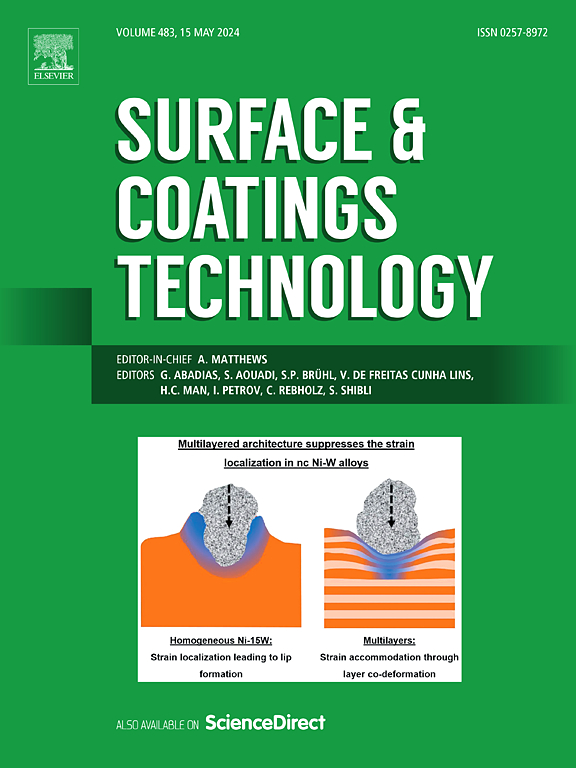全关节置换术用铂基金属合金涂层的抗菌和生物相容性评价
IF 6.1
2区 材料科学
Q1 MATERIALS SCIENCE, COATINGS & FILMS
引用次数: 0
摘要
假体周围关节感染(PJI)是骨科手术中一种具有挑战性的并发症,由假体表面的细菌生物膜形成驱动。随着抗菌素耐药性的增加,迫切需要不依赖抗生素的抗菌涂层。铂基涂层具有优异的化学惰性、耐腐蚀性和机械稳定性,使其成为高摩擦下关节植入物表面的潜在候选材料。本研究考察了三种铂基合金:铂铱(PtIr)、铂锆(PtZr)和铂铜(PtCu)的抗菌潜力。这些合金被溅射涂覆在钛基板上,产生薄(~ 85 nm)和光滑(Ra ~ 24 nm)的涂层。利用能量色散x射线光谱(EDX)分析涂层的成分,并通过电感耦合等离子体光学发射光谱(ICP-OES)定量离子释放。细胞毒性根据ISO 10993-5进行评估,使用成纤维细胞活力测定,确认生物相容性。通过对金黄色葡萄球菌和大肠杆菌接种,评价了涂层的抗菌性能。孵育4小时后,对贴壁细菌进行定量。PtCu涂层的细菌粘附率降低了1倍,而PtIr和PtZr涂层没有明显的抗菌效果。虽然目前的pt基合金涂层没有达到临床所需的抗菌效果,但研究结果为其潜力提供了见解。提高PtCu合金中的铜含量可以提高抗菌效果。此外,将其他已知的抗菌金属,如银或锌,加入到pt基合金中,并增加其在涂层中的重量百分比,可以进一步提高抗菌性能。本文章由计算机程序翻译,如有差异,请以英文原文为准。
Antimicrobial and biocompatibility assessment of platinum-based metal alloy coatings for total joint arthroplasty
Periprosthetic joint infection (PJI) is a challenging complication in orthopedic surgery, driven by bacterial biofilm formation on implant surfaces. With rising antimicrobial resistance, antibacterial coatings that do not rely on antibiotics are urgently needed. Platinum-based coatings offer exceptional chemical inertness, corrosion resistance, and mechanical stability, making them potential candidates for articulating implant surfaces subjected to high friction. This study investigated the antimicrobial potential of three platinum-based alloys: platinum‑iridium (Pt![]() Ir), platinum‑zirconium (Pt
Ir), platinum‑zirconium (Pt![]() Zr), and platinum‑copper (Pt
Zr), and platinum‑copper (Pt![]() Cu). These alloys were sputter-coated onto titanium substrates, producing thin (∼85 nm) and smooth (Ra ∼24 nm) coatings. The composition of the coatings was analyzed using energy-dispersive X-ray spectroscopy (EDX), and ion release was quantified via inductively coupled plasma optical emission spectrometry (ICP-OES). Cytotoxicity was assessed according to ISO 10993-5, using fibroblast viability assays, which confirmed biocompatibility. Antibacterial properties were evaluated by exposing the coatings to Staphylococcus aureus and Escherichia coli inocula. After a 4-hour incubation period, adherent bacteria were quantified. The Pt
Cu). These alloys were sputter-coated onto titanium substrates, producing thin (∼85 nm) and smooth (Ra ∼24 nm) coatings. The composition of the coatings was analyzed using energy-dispersive X-ray spectroscopy (EDX), and ion release was quantified via inductively coupled plasma optical emission spectrometry (ICP-OES). Cytotoxicity was assessed according to ISO 10993-5, using fibroblast viability assays, which confirmed biocompatibility. Antibacterial properties were evaluated by exposing the coatings to Staphylococcus aureus and Escherichia coli inocula. After a 4-hour incubation period, adherent bacteria were quantified. The Pt![]() Cu coating achieved a 1-log reduction in bacterial adherence, while Pt
Cu coating achieved a 1-log reduction in bacterial adherence, while Pt![]() Ir and Pt
Ir and Pt![]() Zr coatings displayed no significant antibacterial effects. Although the current Pt-based alloy coatings did not achieve the clinically required antibacterial effect, the findings provide insights into their potential. Enhancing the copper content in Pt
Zr coatings displayed no significant antibacterial effects. Although the current Pt-based alloy coatings did not achieve the clinically required antibacterial effect, the findings provide insights into their potential. Enhancing the copper content in Pt![]() Cu alloys could improve antibacterial efficacy. Additionally, incorporating other known antibacterial metals, such as silver or zinc, into Pt-based alloys and increasing their weight percentage in the coating could further enhance antibacterial properties.
Cu alloys could improve antibacterial efficacy. Additionally, incorporating other known antibacterial metals, such as silver or zinc, into Pt-based alloys and increasing their weight percentage in the coating could further enhance antibacterial properties.
求助全文
通过发布文献求助,成功后即可免费获取论文全文。
去求助
来源期刊

Surface & Coatings Technology
工程技术-材料科学:膜
CiteScore
10.00
自引率
11.10%
发文量
921
审稿时长
19 days
期刊介绍:
Surface and Coatings Technology is an international archival journal publishing scientific papers on significant developments in surface and interface engineering to modify and improve the surface properties of materials for protection in demanding contact conditions or aggressive environments, or for enhanced functional performance. Contributions range from original scientific articles concerned with fundamental and applied aspects of research or direct applications of metallic, inorganic, organic and composite coatings, to invited reviews of current technology in specific areas. Papers submitted to this journal are expected to be in line with the following aspects in processes, and properties/performance:
A. Processes: Physical and chemical vapour deposition techniques, thermal and plasma spraying, surface modification by directed energy techniques such as ion, electron and laser beams, thermo-chemical treatment, wet chemical and electrochemical processes such as plating, sol-gel coating, anodization, plasma electrolytic oxidation, etc., but excluding painting.
B. Properties/performance: friction performance, wear resistance (e.g., abrasion, erosion, fretting, etc), corrosion and oxidation resistance, thermal protection, diffusion resistance, hydrophilicity/hydrophobicity, and properties relevant to smart materials behaviour and enhanced multifunctional performance for environmental, energy and medical applications, but excluding device aspects.
 求助内容:
求助内容: 应助结果提醒方式:
应助结果提醒方式:


